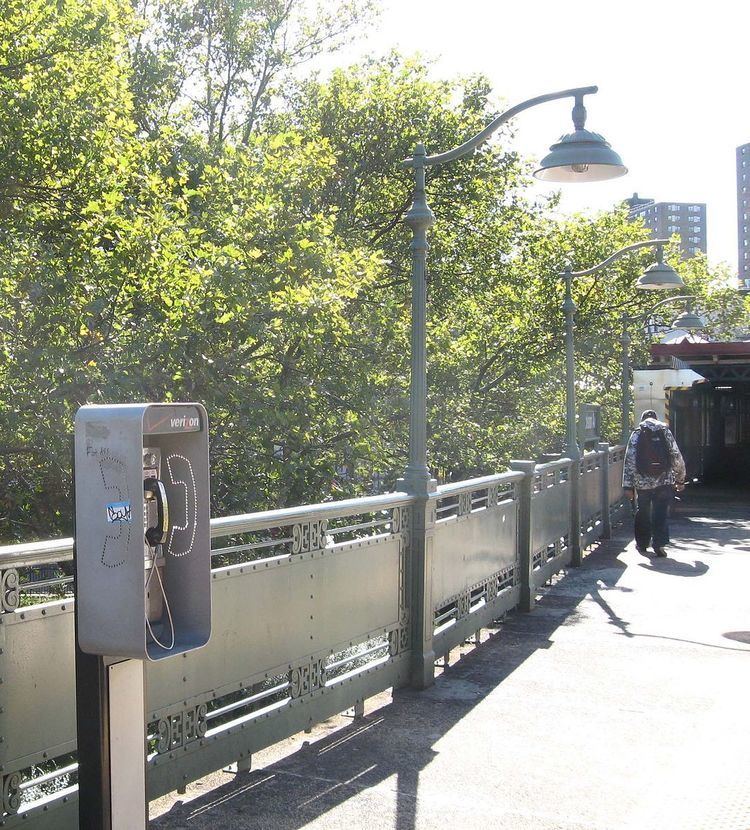Division A (IRT) Structure Elevated Borough The Bronx Added to NRHP 17 September 2004 | Transit connections NYCT Bus: Bx4, Bx4A Platforms 2 side platforms Locale Melrose Tracks 3 | |
 | ||
Line IRT White Plains Road Line Services 2 (all times)
5 (all except late nights and rush hours, peak direction) Address Bronx, NY 10455, United States Similar Intervale Avenue, Prospect Avenue, 219th Street, Freeman Street, 174th Street | ||
Jackson Avenue is a local station on the IRT White Plains Road Line of the New York City Subway. Located at the intersection of Jackson and Westchester Avenues in Melrose, Bronx, it is served by the 2 train at all times, and the 5 train at all other times except during late nights and rush hours in the peak direction.
Contents
History
The first contract for the construction of a subway in New York, Contract 1, was executed on February 21, 1900, between the Board of Rapid Transit Railroad Commissioners and the Rapid Transit Construction Company, organized by John B. McDonald and funded by August Belmont, for the construction of the subway and a 50-year operating lease from the opening of the line. Contract 1 called for the construction of a line from City Hall north to Kingsbridge and a branch under Lenox Avenue and to Bronx Park.
The initial segment of the IRT White Plains Road Line opened on November 26, 1904 between East 180th Street and this station. Initially, trains on the line were served by elevated trains from the IRT Second Avenue Line and the IRT Third Avenue Line, with a connection running from the Third Avenue local tracks at Third Avenue and 149th Street to Westchester Avenue and Eagle Avenue. Once the connection to the IRT Lenox Avenue Line opened on July 10, 1905, trains from the newly opened IRT subway ran via the line. Elevated service via this connection was resumed on October 1, 1907 when Second Avenue locals were extended to Freeman Street during rush hours.
On July 1, 1917, a new connection between the White Plains Road Line and the Third Avenue el express tracks was opened as part of the Dual Contracts expansion of the Third Avenue Line, and since it ran via Bergen Avenue and bypassed the 149th Street station, it was called the Bergen Avenue cutoff or bypass. The Bergen Avenue cutoff was abandoned on November 5, 1946, as part of the gradual curtailment of elevated service on the IRT Third Avenue Line. The cutoff was removed in 1950.
On June 13, 1949, the platform extensions at this station, as well as those on White Plains Road Line stations north to 177th Street, opened. The platforms were lengthened to 514 feet to allow full ten-car express trains to platform. Previously the stations could only platform six car local trains.
Station layout
This station has three tracks and two side platforms. The center express track is used by the 5 train during rush hours in the peak direction. West of this station, the elevated structure widens with room for two more tracks, where the connection to the Third Avenue Line was located. These tracks diverged, with the connection to the Third Avenue local tracks going via Westchester Avenue, and the connection to the Third Avenue express tracks, the Bergen Avenue bypass going south via Bergen Avenue. Beyond the vestiges of the old connections, the line curves west and enters the tunnel into Third Avenue – 149th Street. Because this station is near the tunnel portal, it is closer to the ground than the other elevated stations further north on the line.
Both platforms have beige windscreens with green outlines and red canopies with green support frames and columns in the center and lime green, waist-high, steel fences at either ends. The station signs are in the standard black with white lettering.
This station has been listed on the National Register of Historic Places since September 17, 2004. The 2009 artwork here is called Latin American Stories by George Crespo. It consists of four stained glass panels on the windscreens of each platform and two sets of window niches on each station house. They depict images from six Latin American stories, including How Fire Came to the Rain Forest and The King That Tried to Touch the Moon from the Lesser Antilles.
Exits
Both sides have an elevated station house adjacent to and towards the rear of their respective platforms and there are no crossovers or crossunders. On the Manhattan-bound side, doors from the platform lead to a small waiting area, where a turnstile bank provides entrance/exit from the station. Outside of fare control, there is a token booth and two sets of doors leading to two staircases facing in opposite directions that go down to the west side of Westchester Avenue. The platform has two exit-only turnstiles, each of which leads to either street staircase, to allow passengers to exit the station without having to go through the station house.
The station house on the northbound platform is unstaffed. Four doors lead to a waiting area where two High Entry/Exit Turnstiles and one exit-only turnstile provide access to/from the station. Outside fare control, a set of doors lead to balcony where two double-flight, twisting staircases go down to the northeast corner of Westchester and Jackson Avenues. The platform has one exit-only turnstile leading to the staircase balcony.
